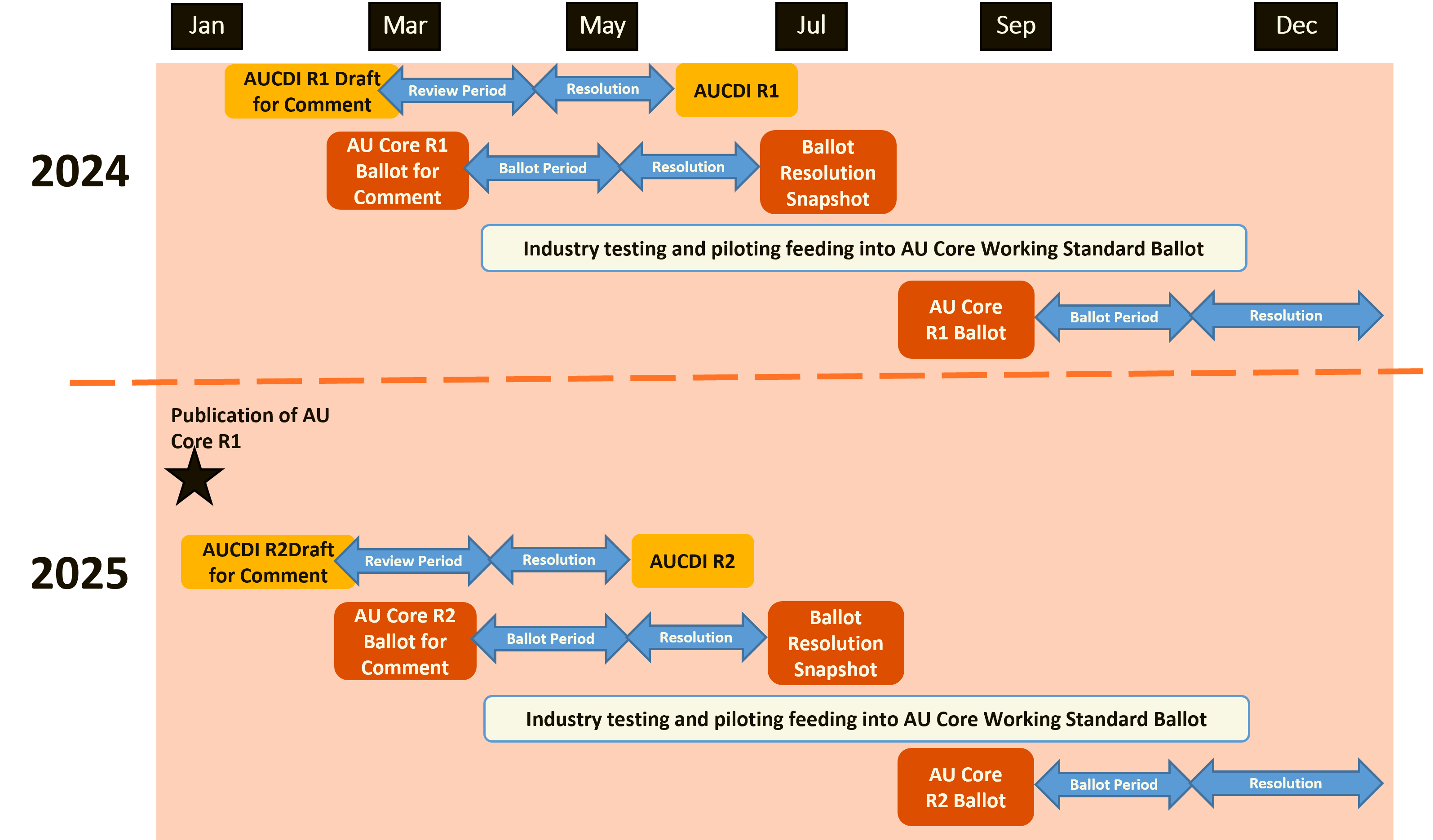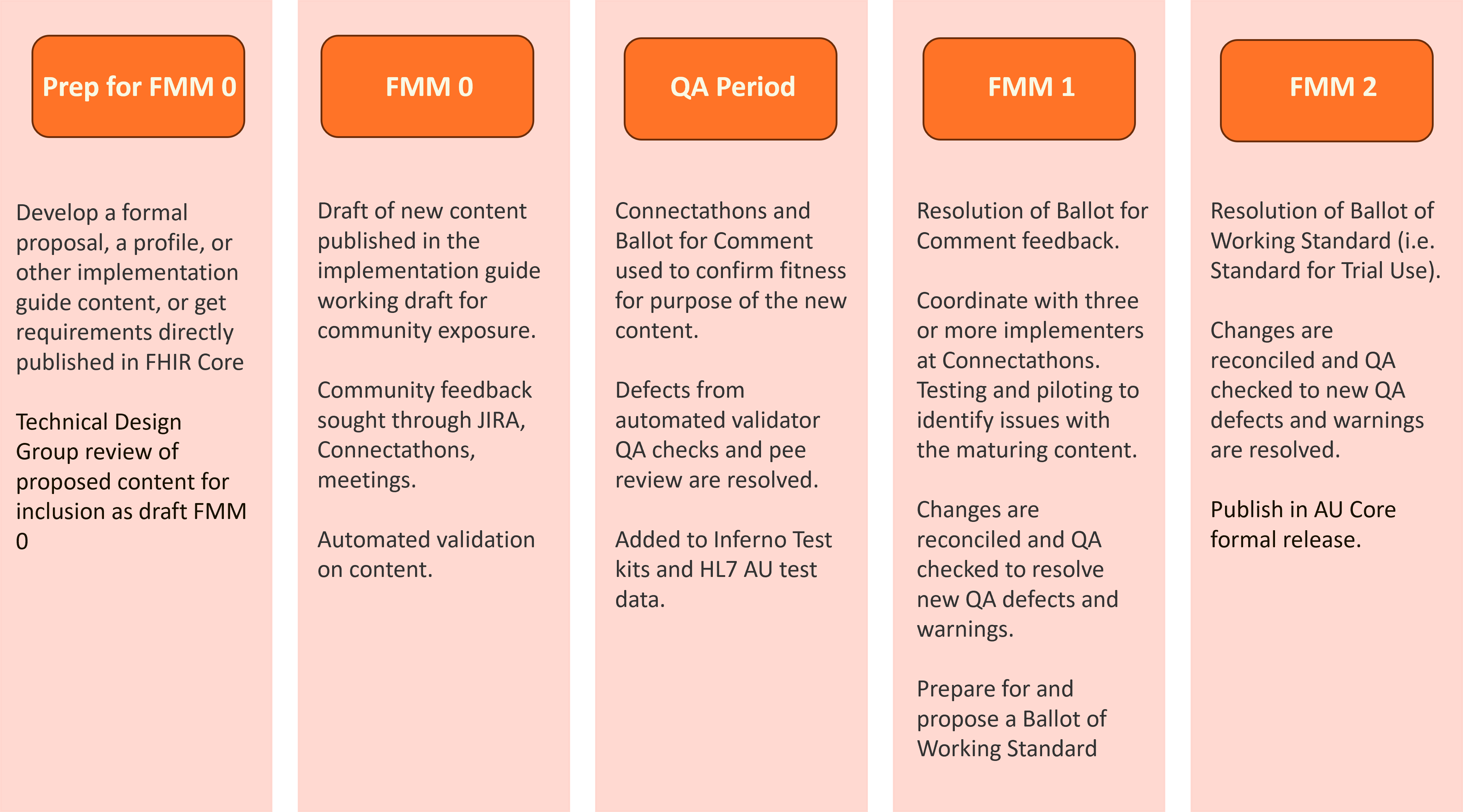This page is part of the AU Core (v1.0.0-ballot: AU Core R1 Ballot 7) based on FHIR (HL7® FHIR® Standard) R4. . For a full list of available versions, see the Directory of published versions
Future of AU Core
AU Core Yearly Updates
AU Core will be published yearly. Yearly AU Core updates reflect changes to:
- Australian Core Data for Interoperability (AUCDI)
- requests from the AU FHIR community.
The approach is outlined in the figure below:
Figure 1: Yearly update of AU Core
AU Core R1 Development process
The first release of AU Core is an 18 month process from HL7 AU proposal to publication of the first release, outlined in the figure below:
Figure 2: AU Core R1 Development process
Maturing the Baseline
The approach to develop and mature AU Core is outlined below making reference to the FHIR Maturity Level (FMM) levels is shown in the figure below.
Figure 3: Maturing the AU Core baseline
Future Candidate Requirements Under Consideration
The following items are under consideration to add to AU Core.
- Last Updated: AUCDI element Last Updated is intended to reflect when a data group was last updated, capturing clinical relevance and currency. A known and implemented solution in other jurisdictions for similar requirements is the use of the Provenance resource. An alternative to the use of Provenance may be the definition of custom extensions. Future versions of AU Core will develop and test approaches to addressing Last Updated.
- AU Core MedicationStatement: Development and testing of AU Core MedicationStatement profile to support AUCDI Medication Use Statement is planned for the AU Core R2 scope.
- Dosage: The Dosage data type is complex, and the requirements in AU Base Dosage are not sufficient to provide clarity on the minimum requirements for supporting dosage and timing in Australia. Future versions of AU Core will develop and test an AU Core Dosage profile to support common implementation of medicine information.
- Composition: Future versions of AU Core will develop and test AU Core Composition profile to support approaches to sharing clinical documents across multiple use cases.
- DocumentReference: Future versions of AU Core will develop and test an AU Core DocumentReference profile to support sharing of clinical notes across multiple use cases to support common implementation.
- RelatedPerson: Development and testing of AU Core RelatedPerson profile to support the exchange of core digital health and administrative information that involves persons with a personal relationship or non-healthcare-specific professional relationship to the patient is planned for the AU Core R2 scope.
- HealthcareService: Development and testing of AU Core HealthcareService profile to define minimum requirements for healthcare service information across multiple use cases to support common implementation. Work will also be undertaken to consider guidance on resource selection across HealthcareService, PractitionerRole, Organization, and Location.
- Device: Use of the Device resource for medical devices, and devices that perform, observe, or author clinical data, are required to support multiple downstream use cases including eRequesting and patient summary. Future versions of AU Core will develop and test profiles to support common implementation of Device information.
- Coverage: Use of the Coverage resource is required to support multiple downstream use cases including eRequesting. Future versions of AU Core will develop and test minimum requirements for coverage across multiple use cases to support common implementation.
- ServiceRequest: Use of the ServiceRequest resource is required to support multiple downstream use cases including eRequesting. Future versions of AU Core will develop and test minimum requirements for requests across multiple use cases to support common implementation.
- Diagnostic Results: Additional AU Core profiles to support common implementation of additional aspects of diagnostic results including imaging, specimen, and reports will be developed and tested in future versions of AU Core.
- Key clinical elements and Missing Data requirements: It is not clear at this point whether there is a case for prohibiting ‘missing data’ on resource.code e.g. AllergyInterolance.code, Condition.code, or Medication.code. At this time it is not clear how prohibition could be structured in AU Core noting there is no equivalent obligation code for ‘don’t allow missing data’ and as the data type for these elements is CodeableConcept, preadoption of R5 mustHaveValue is not applicable (only for primitive types).
- Record or Update Data: Systems may use operations that create and update resources for any of the profiles in this IG. However, more guidance and minimum requirements need to be developed and tested on writing and updating data in the context of AU Core implementations.
- Profile Only implementation clarity: Additional clarification on how to implement AU Core as Profile Only may be useful as a Profile Only Server CapabilityStatement.
- Guidance on downstream implementation of AU Core: Future versions of AU Core will provide further detail on how to address implementation of AU Core through adoption of AU Core in other FHIR Specifications.


